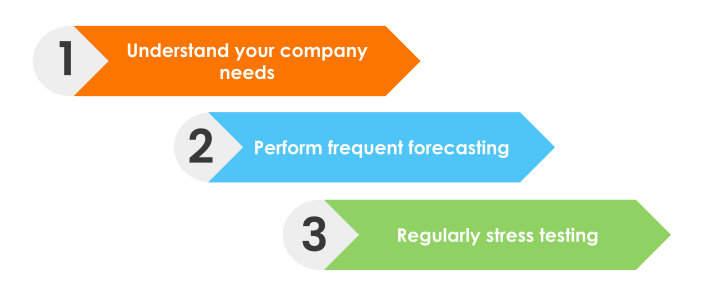A Treasurer’s Guide to Begin with Short-Term Cash Forecasting using Cash Flow Tracking Software
What you’ll learn
- Learn the purpose of short-term cash forecasting
- Overcome the roadblocks of short-term forecasting
Short-term cash forecasting: All you need to know
Short-term cash forecasting is the process of planning and budgeting funds for a short period of time. The time frame is less than a year, ranging from one to six months.Reasons for short-term cash forecasting over long-term cash forecasting
Long-term forecasts are not always reliable due to unforeseen economic downturns, but short-term forecasting keeps companies ahead of the curve by successfully managing working capital by decreasing credit borrowed for operating expenses and considering market fluctuations scenarios. A short-term cash forecast is mostly used for short-term liquidity planning and keep a track of daily cash movements on a frequent basis along with that here are the following purpose of short-term forecasting:- Identifies weaknesses in the revenue cycle
- Capture different ‘what-if’ scenarios and plan business strategies to prevent losses
- Prevent falling short on cash during volatile times
- To borrow effectively and proactively
Roadblocks in short-term cash forecasting
Here are the following bottlenecks of manual short-term cash forecasting:
-
Challenges of tracking customer payment patterns:
Each customer pays in a different way, and different invoices have varying dollar amounts. As a result, all payments are not made at the same time. Therefore, manually tracking varied consumer payment trends is difficult.
-
Incorporating multiple customer-specific variables in cash forecasts manually:
Adding customer-specific variables manually using a spreadsheet is likely impossible and challenging at the same time.
-
Tracking various market fluctuations:
Manually tracking market changes such as raw material price variations, interest rate changes, and commodity rate fluctuations is difficult and error-prone which leads to inaccurate cash forecasts.
How to get started with short-term forecasting
To get started with short-term follow these three steps:

-
Step 1: Understand your company needs:
To determine the best effective cash forecasting approach and tools, first assess your company’s size, mission, performance, and budget. Every company begins with short-term forecasting in order to maintain track of their daily cash flows on a regular basis. Direct cash forecasting allows for more granular analysis and insight.
-
Step 2: Perform frequent forecasting:
Frequent forecasting will assist in understanding various market movements such as raw material price variations, interest rate changes, and commodity rate fluctuations, as well as providing the clearest, most up-to-date image of short-term cash balances and prospective liquidity requirements.
-
Step 3: Regular stress testing:
The fallout from the outbreak of COVID-19 has created a new, previously unimagined worst-case scenario for the majority of businesses. Stress testing under various assumptions helps companies to have a constant eye on worst-case scenarios.
Embracing AI-cash flow tracking software for short-term cash forecasting
AI-cash flow tracking software to overcome the above-mentioned roadblocks:
-
Track customer payment patterns regularly:
Late payments have a negative impact on companies, AI can assist Identify high-risk customers by analyzing consumer payment terms and credit scores using customer historical data which helps to prevent liquidity shortage.
-
Use multiple customer-specific variables with AI cash flow forecasting:
A/R is one of the toughest forecasting categories especially for the short-term to overcome this roadblock AI cash flow forecasting solution uses 30+ customer-specific variables to predict accurate payment dates of companies accounts receivable.
-
Use cash flow tracking software to track various market fluctuations:
Treasurers can assess various scenarios, market fluctuations and determine their influence on the company’s cash flows by changing cash forecasting. This makes it easier to take proactive action after making a decision.
Benefits of short-term cash forecasting utilizing AI cash flow forecasting Tool
-
Make confident decisions:
Real-time data allows for confident borrowing, investing, mergers and acquisitions, and working capital decisions. Automation enables treasurers to make better financial decisions by providing accurate insights into cash requirements.
-
Continuous improvements in accuracy:
AI cash forecasting tool enables a complete feedback loop model that analyzes historical and current performance and adjusts estimates to improve cash forecast accuracy by up to 95%.
-
Scenario planning through Excel-on-Web:
Risk management is simplified with AI-based scenario planning, which involves making tiny adjustments to data in a spreadsheet.
-
Improve variance analysis:
Drill down into forecast variances across all cash flow categories, regional, and company levels to spot, report and fix the reasons for the variations and validate the accuracy of the current forecast.
There's no time like the present
Get a Demo of Integrated Receivables Platform for Your Business
Request a Demo
HighRadius Integrated Receivables Software Platform is the world's only end-to-end accounts receivable software platform to lower DSO and bad-debt, automate cash posting, speed-up collections, and dispute resolution, and improve team productivity. It leverages RivanaTM Artificial Intelligence for Accounts Receivable to convert receivables faster and more effectively by using machine learning for accurate decision making across both credit and receivable processes and also enables suppliers to digitally connect with buyers via the radiusOneTM network, closing the loop from the supplier accounts receivable process to the buyer accounts payable process. Integrated Receivables have been divided into 6 distinct applications: Credit Software, EIPP Software, Cash Application Software, Deductions Software, Collections Software, and ERP Payment Gateway - covering the entire gamut of credit-to-cash.



